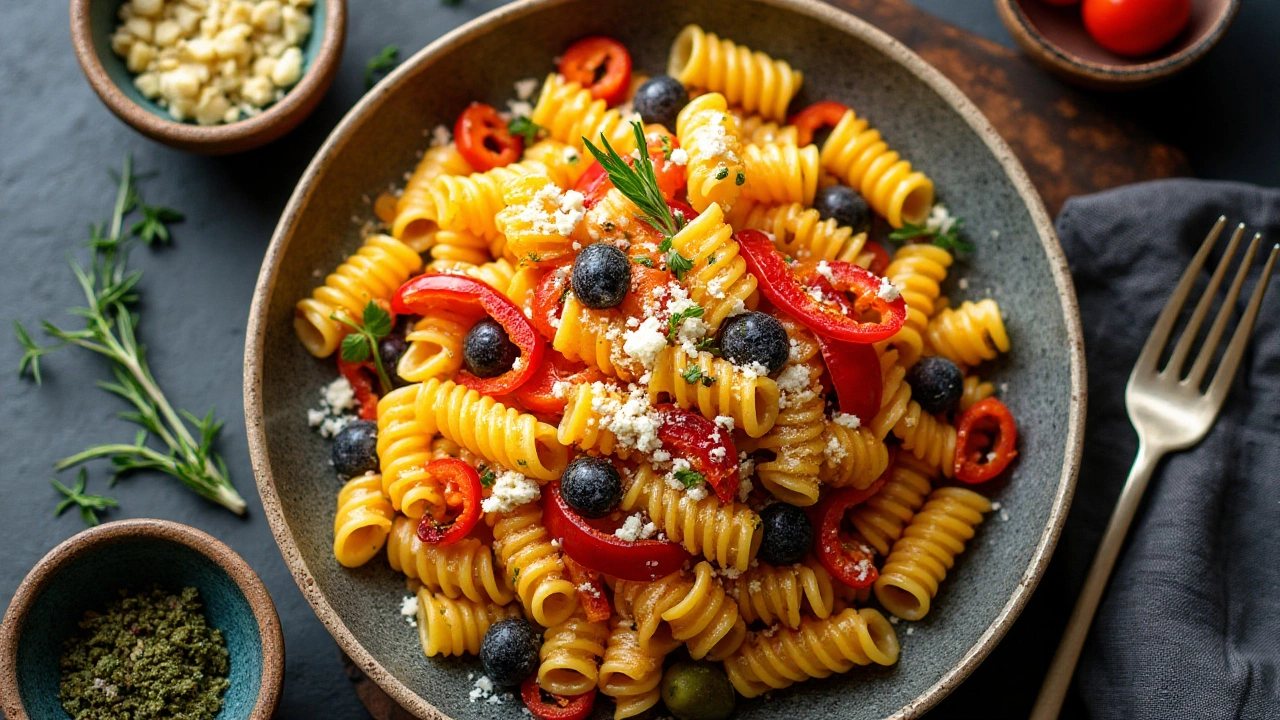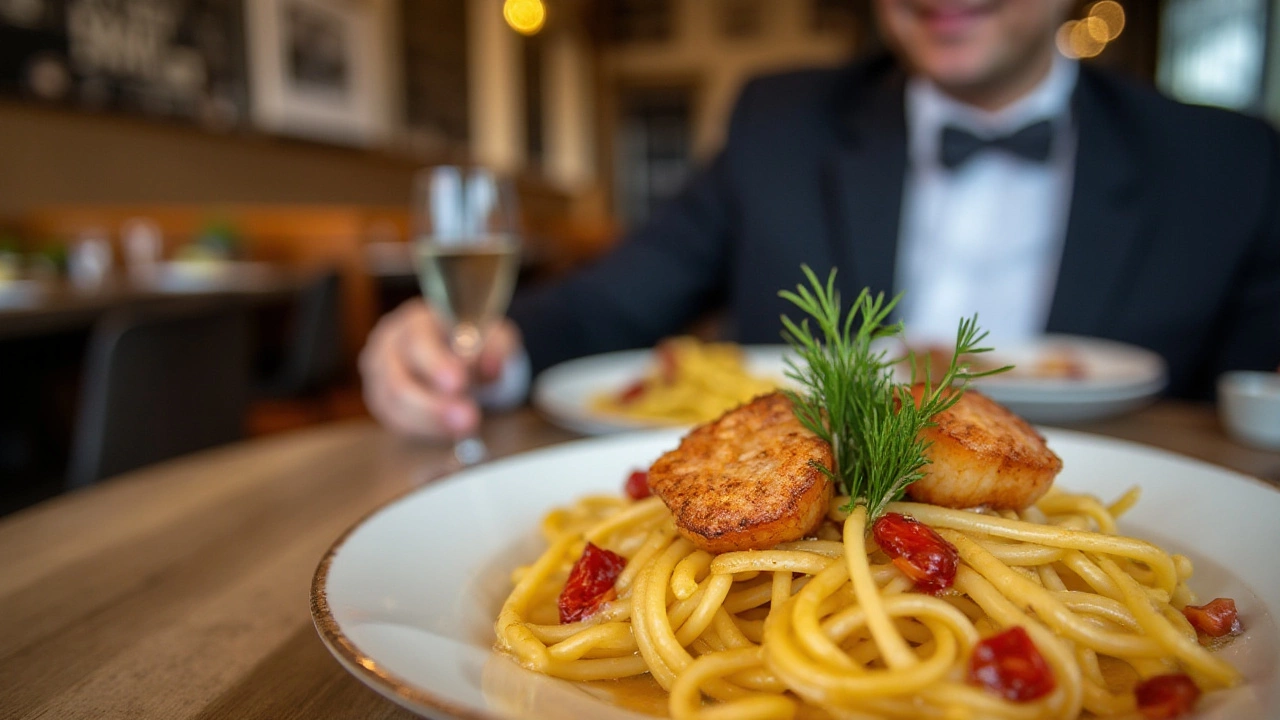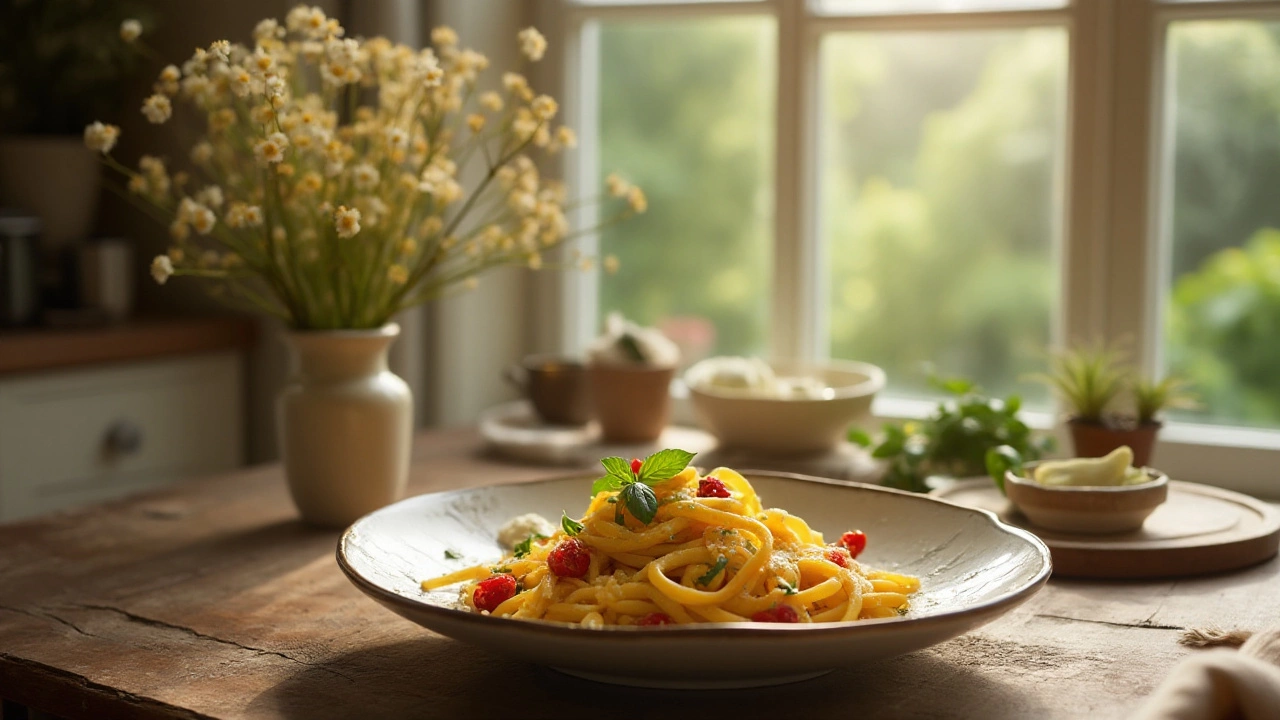Pasta, beloved by many, often needs a little something extra to make it truly shine. This staple of Italian cuisine is versatile, acting as a blank canvas ready to absorb fantastic flavors. Whether you're a purist who delights in simplicity or an adventurer seeking bold combinations, enhancing pasta goes beyond just adding sauce.
Imagine the aromatic allure of garlic sautéed in olive oil or the earthy richness of fresh basil sprinkled on top. Consider the creaminess of freshly grated parmesan or the savory depth of crispy pancetta. Each ingredient brings its own unique charm, and even the smallest addition can make a world of difference.
- The Power of Herbs and Spices
- Cheeses That Transform
- Vegetables to Enhance Flavor
- Meats and Proteins for Heartiness
- Unexpected Ingredients for a Twist
- Tips for Perfect Pasta Presentation
The Power of Herbs and Spices
When it comes to enhancing your pasta dishes, few things carry the vibrant, mouthwatering impact that herbs and spices do. These transformative elements can elevate your meal from simple to spectacular with hardly any effort. Fresh herbs such as basil, oregano, and parsley bring life to the plate, offering aromas and nuances that awaken the senses even before the first bite. Dried varieties provide concentrated flavors that are perfect for long-simmered sauces. Meanwhile, spices like crushed red pepper, black pepper, or sweet paprika introduce a dimension of heat and depth that can make a seemingly straightforward dish unforgettable.
Culinary experts often regard garlic as an integral part of any pasta masterpiece, not only for its robust character but also for its health benefits. Sautéing garlic in olive oil releases its essential oils, embedding a rich flavor throughout your pasta recipes. A sprinkle of nutmeg marries beautifully with creamy sauces, offering a warming, aromatic undertone that's subtly seductive. Rosemary, often associated with heavier dishes, can be chopped finely and used sparingly to lend an earthy fragrance, reminiscent of Mediterranean shores.
The celebrated chef Marcella Hazan once said, "The smell of freshly made pasta is a great memory trigger that adds a dash of nostalgia to the experience of tasting."
Add to this the lemony zest of thyme, a herb that can brighten heavier, tomato-based sauces with its bright and fresh notes. It's fascinating how a pinch of something so small can ripple through a dish, impacting not just taste, but the mood of a meal. The alchemy of combining multiple herbs and spices creates layers of flavor that speak of tradition, region, and creativity.
Consider the subtle sweetness of fennel seeds, which can introduce a mild licorice note, complementing the savory elements for a balanced finish. An intriguing use of such spices elevates what might be a usual dinner into a story told through flavors. Even the unassuming dried bay leaf has its place simmering away in sauces, imparting its unique essence. Understanding these plants’ personalities—and how they can work together—may very well be the secret to becoming a master of pasta.
Cheeses That Transform
Delving into the world of cheeses can change the way we experience pasta. Cheese isn't just about adding a creamy texture, but about elevating and complementing the essence of the dish. Imagine the tanginess of aged Pecorino Romano, which has been a staple in Italian culinary tradition for centuries. This specific cheese adds not just saltiness, but an umami depth that harmonizes beautifully with tomato-based sauces. On the other hand, a creamy ricotta can create a luscious, velvety sauce when mixed with hot pasta, offering a subtle sweetness that balances strong spicy elements in dishes such as 'Arrabbiata'.
Let's not forget the classic appeal of mozzarella. This cheese, known for its melting properties, plays a crucial role in transforming baked pasta dishes such as 'lasagna' or 'baked ziti'. Its gooey texture enhances the experience, making every bite a comforting indulgence. Unique cheeses like Gorgonzola, with its distinct bold flavor, can add a surprising twist to your pasta, marrying well with walnuts and pears for an exquisite level of sophistication.
The cheese world is vast, with selections like Parmigiano-Reggiano often being referred to as the 'king of cheese'. It’s aged for at least 12 months, which enriches its flavor profile and makes it an excellent topping grated just before serving. Cheese aficionados have often said,
"A sprinkling of Parmigiano is like a dash of sunlight on a cloudy day,"illustrating its ability to brighten even the simplest dishes. Cheeses carry their own unique histories and flavors, each one a small universe of tastes waiting to be explored and enjoyed.
For those looking to experiment, blending cheeses can also yield tantalizing results. Try a mix of Fontina and Gruyère in your next pasta bake for an irresistible sharp and nutty depth. Even a non-traditional choice like feta, with its crumbly texture and tangy zest, can work wonders in summertime pasta salads. Remember, the beauty of pasta lies in its simplicity that can be enhanced a thousandfold by carefully selecting the right cheese, allowing you to craft a culinary masterpiece right in your kitchen.

Vegetables to Enhance Flavor
When it comes to elevating the flavor profile of your pasta, vegetables are often the unsung heroes that can bring depth, color, and nutrition to your dish. Consider the humble yet vibrant bell pepper; its sweet and mildly spicy notes can infuse your pasta with a delightful complexity. Imagine tossing some roasted red bell peppers into a basic pasta dish—they add a smokiness and subtle sweetness that balance beautifully with savory elements.
Another star player is spinach. Packed with iron and vitamins, fresh spinach wilts quickly when tossed with warm pasta, coating the noodles with its verdant touch. Its slight bitterness complements the richness of creamy sauces or the saltiness of strong cheeses like Parmigiano-Reggiano. These contrasts create a more rounded, invigorating bite, taking your pasta from good to unforgettable.
"Vegetables are a must on a diet. I suggest carrot cake, zucchini bread, and pumpkin pie." - Jim Davis
Mushrooms deserve an honorable mention. Their umami flavor profile adds a savory depth that meat lovers might equate with a good steak. Sautéed in a bit of olive oil and garlic, mushrooms like cremini or shiitake distribute their delicious juices into the pasta, making every forkful a savory sensation. Adding them to dishes such as Fettuccine Alfredo introduces an earthy warmth that enriches the entire meal.
Adding More Color and Crunch
Don't overlook vegetables that add crunch and vibrancy. Zucchini, sliced into thin ribbons, can bring a garden-fresh lightness. On the other hand, broccoli florets offer a crisp texture and a pop of green that can break up the monotony of beige pasta. Steaming or sautéing them lightly keeps their crunch intact while softening their distinct flavors just enough for them to meld beautifully with your chosen pasta dressing.For those who crave a bit of zest, consider incorporating sun-dried tomatoes. Their concentrated flavor offers a punchy blend of sweet, tangy, and slightly chewy textures that can surprise your palate in delightful ways. Combined with a drizzle of high-quality olive oil and a sprinkle of fresh herbs, they can be the key ingredient that turns an ordinary dish into a gourmet delight.
Balancing with Hearty Complements
Pairing vegetables with hearty ingredients can also create a well-balanced dish that feels complete. The subtle sweetness of caramelized onions, for example, can blend with the acidity of tomatoes to create a perfect base for brothy sauces. In some regions, adding peas or artichokes is quite common, both bringing unique flavors and consistency to the meal. Not only do these additions enhance the pasta recipes with their tastes, but they also improve texture and provide a satisfying combination of different mouthfeels.Meats and Proteins for Heartiness
Pasta dishes often gain a new dimension when paired with the right meats and proteins, offering richness and savoriness that elevate them into hearty, satisfying meals. Whether you're preparing a simple weeknight dinner or a more elaborate feast for guests, adding proteins transforms a bowl of pasta from a side dish into a complete meal. Let's explore some of the most popular and delectable options, from classic choices to more adventurous additions.
Beef, particularly ground beef, is a staple in many pasta recipes. Think of a classic Bolognese sauce, where the meat cooks slowly with onions, garlic, tomatoes, and herbs for a depth of flavor that's hard to resist. The key is to let it simmer until it becomes tender, allowing each rich ingredient to meld together beautifully. In contrast, if you're looking for a luxurious touch, consider using beef short ribs. These can be slowly braised in red wine and broth, resulting in melt-in-your-mouth meat that makes any pasta dish unforgettable.
Chicken, versatile and less intense, offers a lighter alternative that doesn't overshadow the pasta. Whether grilled, roasted, or pan-seared, its subtle flavor serves as a perfect companion to any sauce, be it creamy Alfredo or vibrant pesto. For springtime options, slices of lemon-infused grilled chicken provide a refreshing contrast to your pasta.
If seafood is your calling, shrimp can be a perfect match for your pasta. Their sweet, delicate flavor pairs effortlessly with garlic and chili flakes, offering a kick of spice that heightens the experience. Lightly pan-seared or grilled, shrimp should not be overcooked to maintain their tender texture. Pair them with linguine, and you've got yourself a coastal classic.
Pasta enhancements don't stop at traditional meats. For those looking to explore, consider lamb, with its bold, gamey flavor that finds a partner in robust sauces like ragu. Use it ground or in chunks, perhaps with rosemary and olives, to appreciate its unique characteristics fully. Another surprisingly delightful addition is duck, which, when slow-cooked, brings a fork-tender bite that complements creamy sauces indulgently.
As a curious trend, many chefs have explored the potential of plant-based proteins to enrich pasta dishes, a reflection of the modern culinary landscape's shift towards inclusivity and sustainability. Options include tofu, tempeh, and plant-based meat alternatives that mimic the flavor and texture of traditional proteins, widening the horizons for vegetarian and vegan diners.
A balance is crucial. Too much protein can overwhelm the flavors, while too little may leave you craving more depth. Experimenting with different pasta enhancements can awaken new flavors and textures that delight, lending an unexpected twist that surprises and satisfies even the most seasoned testaments to tradition. Embrace this creation process, and let your palate guide your culinary journey.

Unexpected Ingredients for a Twist
Sometimes, the best way to elevate your pasta recipes is by venturing beyond the usual suspects. Certain ingredients might seem unusual at first glance, but they can add layers of flavor and texture that revolutionize a dish. Take for example the rich, umami-packed punch of miso paste. Traditionally a staple in Japanese cuisine, just a spoonful can add depth and an intriguing savory note that balances beautifully with many pasta sauces. Imagine swirling creamy miso into a carbonara or stirring it into a tomato sauce; the umami content transforms the whole meal.
Another intriguing addition could be dark chocolate shavings. Now, before you raise a skeptical brow, consider how a hint of cocoa can enhance savory dishes. In fact, it's a common secret in Mexican mole sauces. A tiny grating of dark chocolate can bring out the richness in a meaty, robust ragu, without transitioning the dish into a dessert.
"Chocolate is happiness that you can eat," said Ursula Kohaupt, highlighting the universal appeal of this ingredient.This unexpected twist surprises the taste buds in the most delightful way.
Fruit in pasta might also sound odd, but it can add a refreshing contrast. Picture thin slices of pear mingling with gorgonzola in a creamy sauce. The sweet and juicy nature of the fruit cuts through the richness of the cheese, creating a balanced dish that surprises with every bite. Or consider a squeeze of lemon zest over a basil pesto pasta. The citrus oil in the zest brightens the dish immensely and elevates it from good to unforgettable.
If you're seeking to allure the avant-garde in culinary adventures, don't shy away from the world of nuts. Roasted crushed hazelnuts or walnuts can lend a crunchy texture and a buttery, toasty flavor to any pasta dish, creating a juxtaposition that is both alluring and satisfying. Combine them with sweet, fresh corn or caramelized onions, and you've got a dish worthy of the finest gourmet tables. And the list does not end there. Ever heard of bottarga? This Italian delicacy is salted, cured fish roe that adds a savory, briny accent without needing much—just a fine sprinkle over pasta like a luxurious finishing salt.
Tips for Perfect Pasta Presentation
Creating a beautiful plate of pasta is as much an art as it is a science. The presentation of this beloved dish can elevate a mealtime experience from ordinary to extraordinary, adding a visual delight to the culinary pleasure. Start with a well-chosen plate – white dishes often offer the best backdrop, enhancing the vibrant colors of the pasta recipes and their toppings. Providing contrast, a dark plate can make a creamy sauce pop, focusing the diners' eyes on the dish's details. It’s crucial to remember, as the adage goes, people eat with their eyes first.
Layering plays a significant role in pasta presentation, with texture contributing to both appearance and taste. For instance, placing a bed of fresh, bright green leaves like spinach or basil can add dimension and color. Above the pasta, consider evenly distributing ingredients with varied hues and shapes – a sprinkle of jewel-toned cherry tomatoes or a garnish of curled lemon zest adds such vivid contrasts. Even the placement of components can imitate the artistry of renowned chefs like Massimo Bottura, known for his intricate yet approachable plating techniques.
The importance of portion size cannot be overstated, providing balance and proportion on the plate. Using a kitchen scale ensures the pasta isn't overwhelming the other ingredients or the serving dish. Swirling long noodles like spaghetti creates height and structural interest, allowing ample room to showcase additional ingredients such as meats, vegetables, or aromatic herbs. Highlighting proteins on top, such as thin slices of grilled chicken or delicate flakes of salmon, draws the eye and invites anticipation.
Adding that final touch with garnishes can completely transform a dish from simple to sophisticated. Finely shredded parmesan or a soft grate of truffle brings luxurious flavors and an enticing aroma. Crunchy elements like toasted nuts or bread crumbs add a delightful texture, breaking the monotony of soft pastas and sauces. As noted in the elegant words of culinary virtuoso Thomas Keller:
"A garnish is the fine thread between savor and savorless."His insight reflects the subtle power of these finishing flourishes.
Light plays a pivotal role, casting gentle highlights and shadows that accentuate the dish’s nuances. Soft, natural lighting enhances the colors without washing them out, a technique used by food stylists to maximize a dish's appeal in photographs and reality alike. When serving pasta indoors, ambient lighting or a table-side candle can create warmth, inviting diners to savor each mouthful in a cozy atmosphere. Pairing the pasta with suitable companions, like a neat napkin or sparkling flatware, contributes to the overall visual harmony on the dining table.

